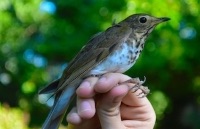Ground-level lights change the behaviour of nocturnally migrating passerines
LINKED PAPER
Anthropogenic light is associated with increased vocal activity by nocturnally migrating birds. Watson, M., Wilson, D. andMennill, D. 2016. The Condor, DOI: 10.1650/CONDOR-15-136.1 VIEW
Many birds migrate at night during the spring and fall migration. Anthropogenic light can have detrimental effects on nocturnally migrating birds. For example, tall lit structures including communication towers, light houses, and skyscrapers attract birds and often results in fatal collisions resulting in millions of bird deaths annually (Loss et al. 2014). In addition, anthropogenic lights can have disorienting effects, which cause birds to expend additional energy on migration (Cochran and Graber 1958, Jones and Francis 2003).
Although the effects of light sources on tall structures have been studied, most sources of anthropogenic light are at ground level. Ground-level anthropogenic light has been found to influence other aspects of avian behaviour, such as timing of nest initiation, the timing of dawn chorus, and the number of extra-pair copulations (Kempenaers et al. 2010). Whether wide spread ground-level lighting effects the behaviour of birds during nocturnal migration has received little attention despite the fact that many birds pass over countless sources of anthropogenic light during their migration.
My coauthors and I used a bioacoustics approach to study the effects of ground-level anthropogenic lights on migration of birds in southern Canada. We used skyward-pointing microphones to survey the nocturnal flight calls produced by birds as they passed over sites with anthropogenic light sources and unlit comparison sites.
During the fall migration, we recorded at 16 locations spread across southern Ontario, Canada. The locations consisted of paired sites, one lit with an anthropogenic light source and one that was unlit. The light sources were broad spectrum lights and we collected measurements of luminescence at each site after sunset. The measurements confirmed that the sites with ground-level lights were significantly brighter than the unlit comparison sites. The light sites fell within the range of values observed for urban sky glow, residential street lights and lit parking lots.

My coauthors and I found that significantly more birds were detected above the sites with ground-level anthropogenic lights, compared to the nearby unlit sites. We recorded a median of 31 calls per night at the artificially lit sites, almost three times the median number of 10.5 calls per night at the unlit sites.

Given that light has been shown to attract nocturnal migrants, the increase in the number of call detections could indicate that ground-level anthropogenic light could be attracting birds during their nocturnal migration. If this were the case we would expect to see an increase in the number of calls detected at light sites, which is exactly what we observed. However, ground-level light could be disorienting birds as they migrate over these sources of light. If birds were being disoriented, we would expect that there would be an increase in calling rate in order to maintain flock cohesion and avoid mid air collisions.
Our results are consistent with the fact that anthropogenic lights affect nocturnally migrating birds. Artificial lights could be causing birds to fly at abnormal altitudes, fly in circuitous paths around light sources, or to call at higher rates. Regardless of which explanation is correct, it appears that anthropogenic light causes birds to migrate inefficiently, increasing the energetic expenditure during migration.
Our research underscores the importance of studying the consequences of anthropogenic modifications to the natural environment. Future studies can help improve our understanding of how these modifications to the natural landscape are affecting different species and allow us to better mitigate the effects of such changes.
References
Cochran, W. W. and Graber, R. R. 1958. Attraction of nocturnal migrants by lights on a television tower. The Wilson Bulletin 70: 378-380. View
Evans, W. R., Akashi, Y., Altman, N. S. and Manville, A. M. II. 2007. Response of night-migrating songbirds in cloud to colored flashing light. North American Birds 60: 476-488. View
Hamilton, W. J. 1962. Evidence concerning the function of nocturnal call notes of migratory birds. The Condor 64: 390-401. View
Jones, J. and Francis, C. M. 2003. The effects of light characteristics on avian mortality at lighthouses. Journal of Avian Biology 34: 328-333. View
Kempenaers, B., Borgström, P., Loës, P., Schlicht, E. and Valcu, M. 2010. Artificial night lighting affects dawn song, extra-pair siring success, and lay date in songbirds. Current Biology 20: 1735-1739. View
Lanzone, M., Deleon, E., Grove, L. and Farnsworth, A. 2009. Revealing undocumented or poorly known flight calls of warblers (Parulidae) using a novel method of recording birds in captivity. The Auk 126: 511-519. View
Loss, S., Will, T., Loss, S. and Marra, P. 2014. Bird-building collisions in the United States: estimates of annual mortality and species vulnerability. The Condor 116: 8-23. View
Image credit
Featured image:
If you want to write about your research in #theBOUblog, then please see here.





